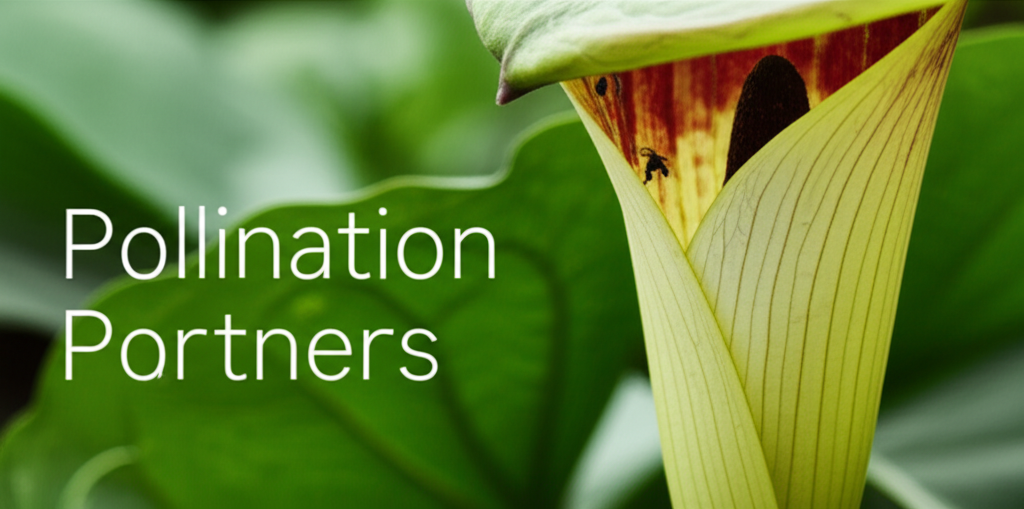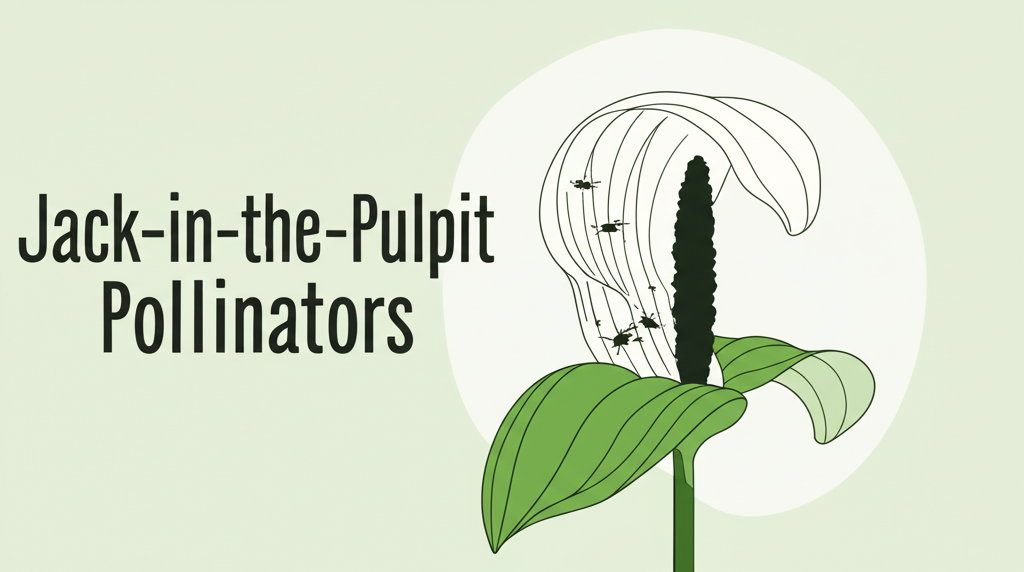Unveiling the Secrets of Jack-in-the-Pulpit Pollination
The Jack-in-the-Pulpit (Arisaema triphyllum) is a fascinating woodland wildflower, instantly recognizable by its unique hooded spathe and spadix. Often found gracing the damp, shaded undergrowth of Eastern North American forests, this plant possesses a reproductive strategy as intricate as its appearance. While its striking form might suggest a more obvious pollinator, the reality is far more subtle and reveals a remarkable reliance on a dedicated group of tiny, often overlooked insects. Understanding these natural pollinators is key to appreciating the plant’s survival and the delicate balance of its ecosystem.
The Enigma of the Spathe and Spadix
Before delving into the pollinators themselves, it’s crucial to understand the specialized structure that dictates their interaction. The Jack-in-the-Pulpit’s “flower” is not a typical blossom. Instead, it’s a modified leaf structure known as an inflorescence, comprising several parts:
- Spathe: The large, hooded, leaf-like structure that encloses the spadix. It is typically green with purple or brown stripes, though color variations exist. The spathe acts as a protective canopy and a visual attractant.
- Spadix: The fleshy, club-shaped spike that emerges from the spathe. It bears the tiny, true flowers, which are typically greenish and inconspicuous. The spadix is the reproductive center of the plant.
- Spadix Appendage: A sterile, whip-like extension of the spadix that protrudes from the spathe. Its exact function is debated, but it may play a role in guiding pollinators or deterring unwanted visitors.
The true magic of Jack-in-the-Pulpit pollination occurs within the spathe, which creates a specialized chamber. The spathe’s hooded nature and the narrow opening at its base are designed to trap specific insects.
The Primary Pollinators: A Dedicated Cohort

The Jack-in-the-Pulpit’s pollination is primarily facilitated by a specific group of flies belonging to the order Diptera. These are not just any flies; they are small, fungus gnats and other minute flies that are attracted to the plant’s subtle scent and the dark, humid environment within the spathe.
Fungus Gnats: The Leading Role
Fungus gnats (family Sciaridae and Mycetophilidae) are the most significant pollinators of Jack-in-the-Pulpit. These small, delicate flies are attracted to the damp, decaying organic matter found in forest soils, making them natural inhabitants of the same environment as the Jack-in-the-Pulpit.
- Attraction: The plant emits a faint, musty odor, somewhat reminiscent of decaying organic material or fermenting fruit, which attracts these fungus gnats.
- Trapping Mechanism: Once inside the spathe, the tiny flies become trapped. The spadix is often covered in downward-pointing hairs, which prevent the flies from escaping easily. The slick interior of the spathe also contributes to their confinement.
- Pollination Process: While trapped, the flies move over the spadix, inadvertently transferring pollen from previously visited flowers to the receptive stigmas (the pollen-receiving parts of the flowers). The true flowers, clustered at the base of the spadix, are where this crucial exchange happens.
- Escape and Reproduction: After a period within the spathe, typically a day or two, the downward-pointing hairs on the spadix wither or bend, allowing the trapped flies to escape. These flies then fly to another Jack-in-the-Pulpit, carrying pollen with them, thus continuing the reproductive cycle.
The fungus gnats are not rewarded with nectar, unlike many other insect pollinators. Their attraction is likely driven by the search for oviposition sites (places to lay eggs) or simply by the humid, enclosed environment that mimics their preferred breeding grounds.
Other Minute Flies
While fungus gnats are the stars of the show, other small flies can also be found within the Jack-in-the-Pulpit’s spathe and contribute to pollination. These might include:
- Shore Flies (Ephydridae): Some species of shore flies, typically found near water, might also be attracted to the damp conditions and scent.
- Midge Flies (Chironomidae): These small, non-biting flies, often mistaken for mosquitoes, can also be occasional visitors.
The specific species of flies involved can vary depending on the geographic location and the availability of alternative resources for these insects.
The Plant’s Strategy: Deception and Adaptation
The Jack-in-the-Pulpit employs a sophisticated strategy of sexual deception to ensure its pollination. It doesn’t offer nectar or abundant pollen as a reward. Instead, it lures its pollinators through scent and by providing a seemingly ideal environment.
The Pseudopollination Concept
This method is often referred to as “pseudopollination” or “trapping pollination.” The plant essentially tricks the insects into performing the vital task of pollination without providing them with sustenance. This is a highly efficient strategy as it conserves the plant’s energy resources, which would otherwise be expended on producing nectar or larger amounts of pollen.
Timing and Flower Sex Determination
Jack-in-the-Pulpit has a fascinating sex determination system. Most plants start as male, producing pollen. After a year or two, they may switch to a female phase, producing berries. Some plants may remain male indefinitely, while others can alternate between male and female phases. This ensures cross-pollination between different plants. The timing of the spathe’s opening and the development of the spadix are synchronized with the activity of its pollinators.
Why These Tiny Insects? The Advantage of Specialization
The reliance on small flies like fungus gnats offers several advantages for the Jack-in-the-Pulpit:
- Reduced Competition: By attracting less flamboyant pollinators, the Jack-in-the-Pulpit avoids direct competition with plants that rely on larger, more generalist pollinators like bees and butterflies.
- Targeted Pollination: The enclosed structure of the spathe ensures that the pollen is delivered directly to the receptive stigmas within the chamber, minimizing pollen loss to wind or ineffective visitors.
- Resource Efficiency: Not needing to produce nectar or large quantities of pollen allows the plant to allocate more resources to growth, development, and berry production.
Key Facts About Jack-in-the-Pulpit Pollination
Here is a summary of the essential aspects of Jack-in-the-Pulpit pollination:
| Characteristic | Details |
|---|---|
| Primary Pollinators | Small flies, particularly fungus gnats (Sciaridae, Mycetophilidae) |
| Attraction Method | Faint, musty scent mimicking decaying organic matter; humid, enclosed environment |
| Pollination Mechanism | Trapping within the spathe; downward-pointing hairs on the spadix prevent escape; accidental pollen transfer while trapped |
| Pollinator Reward | None (no nectar); pseudopollination strategy |
| Plant Structure Involved | Spathe (hooded leaf), spadix (fleshy spike with true flowers) |
| Timing of Pollination | Spring, coinciding with pollinator activity |
| Plant Sex Determination | Sequential hermaphroditism (can be male or female, sometimes alternating) |
The Ecological Significance of This Partnership
The intricate relationship between the Jack-in-the-Pulpit and its tiny fly pollinators is a testament to the power of co-evolution and niche specialization in nature.
Maintaining Biodiversity
This partnership plays a vital role in maintaining the biodiversity of forest ecosystems. The Jack-in-the-Pulpit relies on these specific flies for its reproduction, and in turn, these flies likely depend on the plant for shelter and potential breeding sites. Disruptions to either population can have cascading effects throughout the ecosystem.
Indicator Species
The health of Jack-in-the-Pulpit populations can serve as an indicator of the health of the forest environment. If the pollinators decline due to habitat loss, pesticide use, or climate change, the Jack-in-the-Pulpit will struggle to reproduce. Conversely, the presence of a robust Jack-in-the-Pulpit population suggests a healthy population of its specialized pollinators.
Steps Involved in Jack-in-the-Pulpit Pollination and Pros/Cons
Let’s break down the process and the advantages and disadvantages of this unique pollination strategy.
| Stage | Description | Pros | Cons |
|---|---|---|---|
| Attraction | Flies are drawn by scent and visual cues of the spathe. | Efficiently attracts specific pollinators. | Relies on a subtle scent that might not be universally effective. |
| Entry & Trapping | Flies enter the spathe through the narrow opening and become trapped by downward-pointing hairs and slick surfaces. | Ensures pollinators are in direct contact with flowers; minimizes pollen loss to non-pollinators. | Flies are temporarily immobilized, potentially increasing their vulnerability. |
| Pollination | While trapped, flies move over the spadix, transferring pollen between flowers. | Direct pollen transfer to receptive stigmas. | Pollination success is dependent on the flies’ activity and movement. |
| Escape | Downward-pointing hairs on the spadix wither or bend, allowing flies to exit. | Allows pollinators to escape and continue the cycle. | Some flies might die within the spathe if escape is hindered. |
| Reproduction | Fertilized flowers develop into red berries, which are dispersed by birds. | Successful reproduction leads to seed dispersal and new plant generation. | Reproduction success is entirely dependent on the pollination process. |
Pros of This Pollination Strategy for the Plant:
- High Efficiency: Ensures that pollen reaches the receptive parts of the flower with minimal waste.
- Resource Conservation: Eliminates the need to produce nectar or large pollen rewards, saving energy.
- Reduced Competition: Avoids competition with plants that attract larger, more generalist pollinators.
- Targeted Pollinator Group: Leverages insects that are already present and active in the same habitat.
Cons of This Pollination Strategy for the Plant:
- Vulnerability to Pollinator Decline: Highly dependent on specific pollinator populations, making it susceptible to environmental changes affecting those insects.
- Potential for Pollinator Mortality: If the trapping mechanism fails or if the environment within the spathe becomes unfavorable, pollinators may die before completing their task.
- Limited Pollinator Range: The effectiveness is tied to the presence and activity of very specific, small insect species.
Conservation Concerns and Future Outlook
As with many native wildflowers, the Jack-in-the-Pulpit faces threats from habitat fragmentation, deforestation, and the increasing use of pesticides. The decline of its specialized pollinators, even subtly, could have significant implications for its survival.
Protecting Their Habitat
Preserving the intact forest ecosystems where Jack-in-the-Pulpit thrives is crucial. This includes protecting the soil composition, moisture levels, and canopy cover that support both the plant and its insect partners. Avoiding the use of broad-spectrum insecticides in or near these habitats is also paramount.
Understanding Their Role
A deeper understanding of the Jack-in-the-Pulpit’s pollination biology can inform conservation efforts. Recognizing the importance of small flies and the specific conditions they require helps us appreciate the interconnectedness of the forest food web.
Conclusion
The Jack-in-the-Pulpit, with its beguiling appearance and subtle reproductive strategy, offers a compelling glimpse into the intricate world of plant-pollinator relationships. Its reliance on tiny fungus gnats and other minute flies highlights nature’s ingenuity in utilizing specialized niches. These unsung heroes, often overlooked in their own right, play a critical role in ensuring the perpetuation of this iconic woodland wildflower. By appreciating the delicate balance of this partnership, we gain a greater understanding of the complex tapestry of life in our natural world and the importance of preserving these vital ecosystems.


